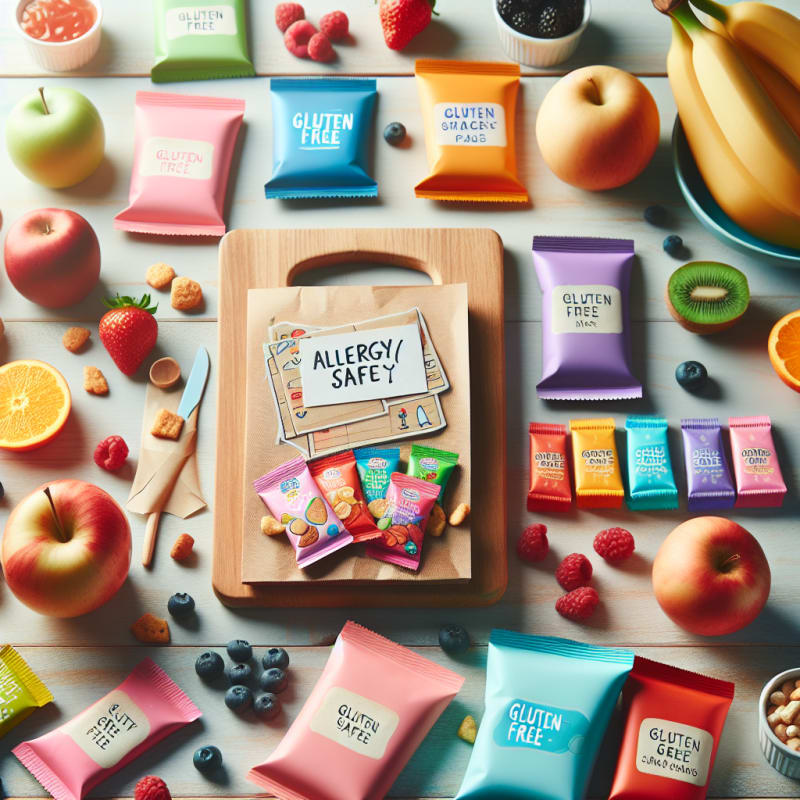Top 10 Gluten-Free Snacks In USA: Navigating Safe & Delicious Choices
Category: Gluten-Free | Focus Keyword: top 10 gluten-free snacks in usa
Introduction: The Rise of Gluten-Free Snacking in America
In the United States, the demand for gluten-free snacks has soared, driven by increasing awareness of celiac disease, gluten intolerance, and evolving dietary preferences. According to the U.S. Food & Drug Administration (FDA), gluten-free labeling is tightly regulated to protect consumers. This article explores the top 10 gluten-free snacks in USA, compares ingredient and labeling standards with Europe, and demonstrates how technology—like the Food Scan Genius app—empowers consumers to make informed choices.
Whether you have celiac disease, gluten sensitivity, or simply wish to avoid gluten, understanding ingredients and regulations is crucial. This guide offers a comprehensive overview, supported by scientific research[1], regulatory insights, and current news[4].
What Makes a Snack Gluten-Free?
A gluten-free snack must contain less than 20 parts per million (ppm) of gluten, as mandated by the FDA[1]. The European Food Safety Authority (EFSA) applies similar standards, though labeling laws differ. In the U.S., products labeled “gluten-free” must meet strict requirements, while the EU allows for “very low gluten” and “gluten-free” categories[2].
| Region | Legal Gluten Limit | Labeling Terms | Authority |
|---|---|---|---|
| USA | <20 ppm | Gluten-Free | FDA |
| EU | <20 ppm (“Gluten-Free”), <100 ppm (“Very Low Gluten”) | Gluten-Free, Very Low Gluten | EFSA |
These differences matter for travelers and those purchasing imported snacks. For example, a product labeled “very low gluten” in Europe may not qualify as gluten-free in the U.S.
Top 10 Gluten-Free Snacks in USA: 2025 Edition
Based on consumer reviews, expert recommendations, and regulatory compliance, here are the top 10 gluten-free snacks in USA:
-
Kind Bars
Why it’s popular: Made with whole nuts, fruits, and honey. All flavors labeled gluten-free and verified by the FDA.
Nutrition: High in fiber, moderate protein.
Source: Kind Snacks -
Blue Diamond Almonds
Why it’s popular: Pure almonds, naturally gluten-free, available in diverse flavors.
Nutrition: Rich in healthy fats, vitamin E.
Source: Blue Diamond -
Enjoy Life Soft Baked Cookies
Why it’s popular: Free from 14 allergens, certified gluten-free.
Nutrition: Lower sugar, safe for multiple sensitivities.
Source: Enjoy Life Foods -
Glutino Pretzel Twists
Why it’s popular: Crunchy, classic pretzel taste without gluten.
Nutrition: Low fat, moderate sodium.
Source: Glutino -
Snyder’s of Hanover Gluten-Free Pretzels
Why it’s popular: Widely available, trusted brand.
Nutrition: Lower calories, satisfying crunch.
Source: Snyder’s of Hanover -
RXBAR Protein Bars
Why it’s popular: Simple ingredients, gluten-free, high protein.
Nutrition: 12g protein per bar.
Source: RXBAR -
Popcorners Chips
Why it’s popular: Made from non-GMO corn, no gluten.
Nutrition: Low calorie, whole grain.
Source: Popcorners -
Larabar Fruit & Nut Bars
Why it’s popular: Minimal ingredients, naturally gluten-free.
Nutrition: No added sugar, vegan.
Source: Larabar -
MadeGood Granola Minis
Why it’s popular: Allergen-free, organic, gluten-free.
Nutrition: Contains vegetables, low sugar.
Source: MadeGood Foods -
Chobani Greek Yogurt (Plain & Flavored)
Why it’s popular: All Chobani yogurts are gluten-free, rich in probiotics.
Nutrition: High protein, calcium.
Source: Chobani
Note: Always check packaging for the latest gluten-free labeling and ingredient changes, as formulations may evolve.
Comparing Ingredients and Safety: USA vs. Europe
Ingredient transparency is crucial for gluten-free consumers. In the U.S., the FDA requires clear allergen labeling, including wheat and gluten. In Europe, EFSA mandates similar disclosures but allows “very low gluten” products, which may be confusing for American consumers[2].
- USA: Strict “gluten-free” labeling, comprehensive allergen disclosure.
- EU: “Gluten-free” (<20 ppm), “very low gluten” (<100 ppm), less uniform allergen labeling.
For travelers or online shoppers, understanding these differences is essential. A snack considered safe in one region may not meet another’s standards. The Food Scan Genius app can help bridge this gap by scanning barcodes and providing region-specific safety information.
How Food Scan Genius Empowers Gluten-Free Choices
Technology is transforming how consumers identify safe snacks. The Food Scan Genius app enables users to scan product barcodes and instantly receive gluten-free status, ingredient breakdown, and region-specific labeling information.
- Instant Safety Checks: Scan any snack to verify gluten-free status per FDA or EFSA standards.
- Ingredient Insights: Detailed breakdown of allergens and additives.
- Geo-optimized Guidance: Alerts if a product’s labeling differs between the U.S. and EU.
- Community Reviews: See real user feedback on taste and safety.
User Testimonial: “As someone with celiac disease, Food Scan Genius has made grocery shopping stress-free. I scan every snack before buying, and the app’s region-specific guidance is invaluable when I travel. Highly recommended!” — Jessica M., New York
Download Food Scan Genius to ensure your snacks are truly gluten-free, wherever you shop.
Scientific Evidence: Why Gluten-Free Matters
Gluten-free diets are essential for individuals with celiac disease and beneficial for those with non-celiac gluten sensitivity. According to PubMed research, gluten triggers an immune response in celiac patients, causing intestinal damage[3]. Even trace amounts can be harmful. The FDA’s 20 ppm threshold is based on clinical studies showing safety at this level[1].
For others, gluten-free snacking may support digestive comfort, though scientific consensus emphasizes the need for medical diagnosis before adopting restrictive diets[3].
Latest News: Gluten-Free Trends and Innovations
- FoodNavigator-USA reports the U.S. gluten-free snack market is projected to grow 8% annually through 2025, driven by health-conscious consumers.
- The New York Times highlights confusion over gluten-free labeling and the importance of apps like Food Scan Genius for safe shopping.
- CNN Health discusses new gluten-free product launches and the role of technology in dietary management.
Frequently Asked Questions (FAQ)
What is the legal definition of gluten-free in the USA?
The FDA defines gluten-free as containing less than 20 ppm of gluten. Products must not contain wheat, rye, barley, or derivatives unless processed to remove gluten.
How can I verify if a snack is gluten-free?
Check for FDA-compliant labeling and scan the product with Food Scan Genius for instant verification and ingredient analysis.
Are gluten-free snacks healthier?
Not necessarily. While they are safe for those with gluten intolerance, nutritional value varies. Always review ingredient lists for sugar, fat, and additives.
Do labeling laws differ between the USA and Europe?
Yes. The U.S. uses a strict “gluten-free” standard (<20 ppm), while Europe allows “very low gluten” products (<100 ppm). Always check regional guidelines.
Conclusion: Empowering Safe Snacking Through Knowledge & Technology
Choosing the top gluten-free snacks in USA requires more than reading labels—it demands an understanding of regulations, ingredients, and global differences. With tools like Food Scan Genius, consumers can confidently navigate aisles, ensuring every snack is safe and delicious.
In a world of complex ingredients and evolving food laws, knowledge is power. Whether you’re shopping at home or abroad, leverage technology and regulatory insights to safeguard your health and enjoy the best gluten-free snacks America has to offer.





